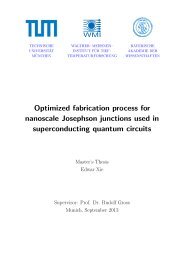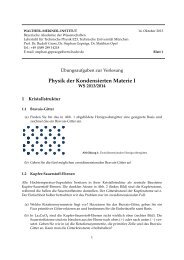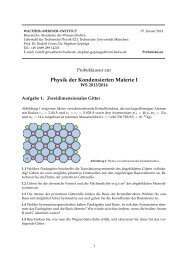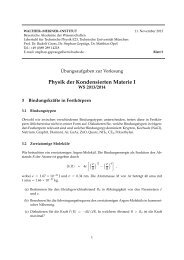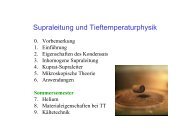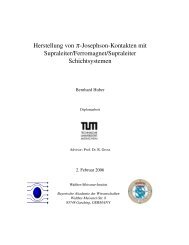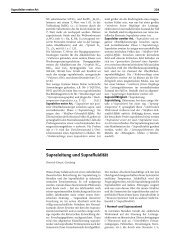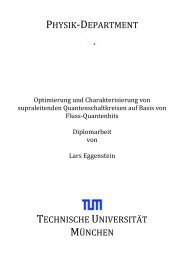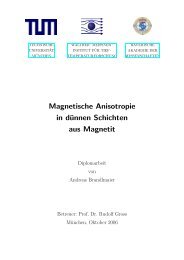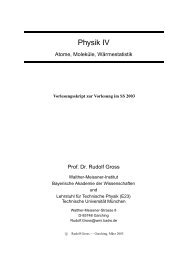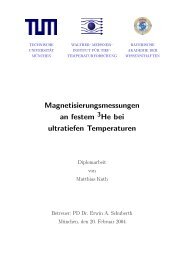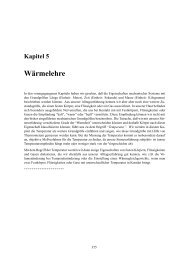Surface magneto-plasmons in magnetic multilayers - Walther ...
Surface magneto-plasmons in magnetic multilayers - Walther ...
Surface magneto-plasmons in magnetic multilayers - Walther ...
You also want an ePaper? Increase the reach of your titles
YUMPU automatically turns print PDFs into web optimized ePapers that Google loves.
Section 2.4<br />
Simulation of the reflectivity of surface <strong>plasmons</strong> 23<br />
θB = arctan<br />
n2<br />
n1<br />
<br />
. (2.48)<br />
n1 and n2 are the refractive <strong>in</strong>dices of the two media. For BK7 the Brewster angle is<br />
about 33.4 ◦ [46] what matches with the simulated value.<br />
With <strong>in</strong>creas<strong>in</strong>g θ the reflectivity <strong>in</strong>creases and reaches 1 at θ ≈ 41.4 ◦ what is quite<br />
similar to the literature value of 41.34 ◦ (Eq. (2.23)). S<strong>in</strong>ce the simulation is done<br />
with a step size of 0.1 ◦ the difference between both values can be expla<strong>in</strong>ed by the<br />
lack of resolution <strong>in</strong> the simulation.<br />
When the prism is covered by a Ag film of dAg = 20 nm (Fig. 2.9(b)) then the<br />
reflectivity for θ = 0 ◦ goes up to 0.67. With <strong>in</strong>creas<strong>in</strong>g θ, R p slowly decreases and<br />
goes through a m<strong>in</strong>imum at θB = 38.6 ◦ and then <strong>in</strong>creases and reaches a maximum<br />
of 0.98 at θc, i.e. for total <strong>in</strong>ternal reflection. At somewhat larger θ, a m<strong>in</strong>imum <strong>in</strong><br />
R p develops at the resonance angle (θSPP = 44.2 ◦ ) of the surface <strong>plasmons</strong>. This can<br />
be expla<strong>in</strong>ed with destructive <strong>in</strong>terference (Sect. 2.3.1).<br />
For silver films with dAg = 50 nm the surface plasmon resonance dip gets sharper<br />
and θSPP shifts to 43 ◦ (Fig. 2.9(c)). While for dAg = 100 nm, a vanish<strong>in</strong>g resonance<br />
appears at θSPP = 42.9 ◦ (Fig. 2.9(d)).<br />
The change of R p at θSPP can be expla<strong>in</strong>ed by radiation damp<strong>in</strong>g [9]. As expla<strong>in</strong>ed<br />
<strong>in</strong> Sect. 2.3.1 the light at the metal-air <strong>in</strong>terface is radiated light <strong>in</strong>to the metal<br />
which <strong>in</strong>terferes with the <strong>in</strong>cident light at the prism-metal <strong>in</strong>terface. S<strong>in</strong>ce, the metal<br />
has a complex dielectric function, this back-radiated light is damped. This effect is<br />
called radiation damp<strong>in</strong>g. On <strong>in</strong>creas<strong>in</strong>g the thickness of the metal films the radiation<br />
damp<strong>in</strong>g <strong>in</strong>creases, so that the destructive <strong>in</strong>terference between the <strong>in</strong>cident and back-<br />
radiated light at the prism-metal <strong>in</strong>terface decreases and thus R p <strong>in</strong>creases. As the<br />
surface plasmon dip <strong>in</strong> R p is due to <strong>in</strong>terference the depth of the surface plasmon dip<br />
(the m<strong>in</strong>imal R p value) thus decreases. Now, decreas<strong>in</strong>g the metal film thickness at a<br />
certa<strong>in</strong> metal film thickness dopt the amplitude of the back-reflected light equals the<br />
amplitude of the <strong>in</strong>cident light and the phase of the back-reflected light is shifted by<br />
π, so that R p = 0. When the thickness is decreased further d < dopt the effect of the<br />
radiation damp<strong>in</strong>g <strong>in</strong>creases aga<strong>in</strong> which yields an <strong>in</strong>crease of R p .<br />
For a s<strong>in</strong>gle layer the optimal layer thickness dopt for which the R p goes to zero at<br />
θ = θSPP can be calculated with a first order approximation equation reported by<br />
Kretschmann [34].



